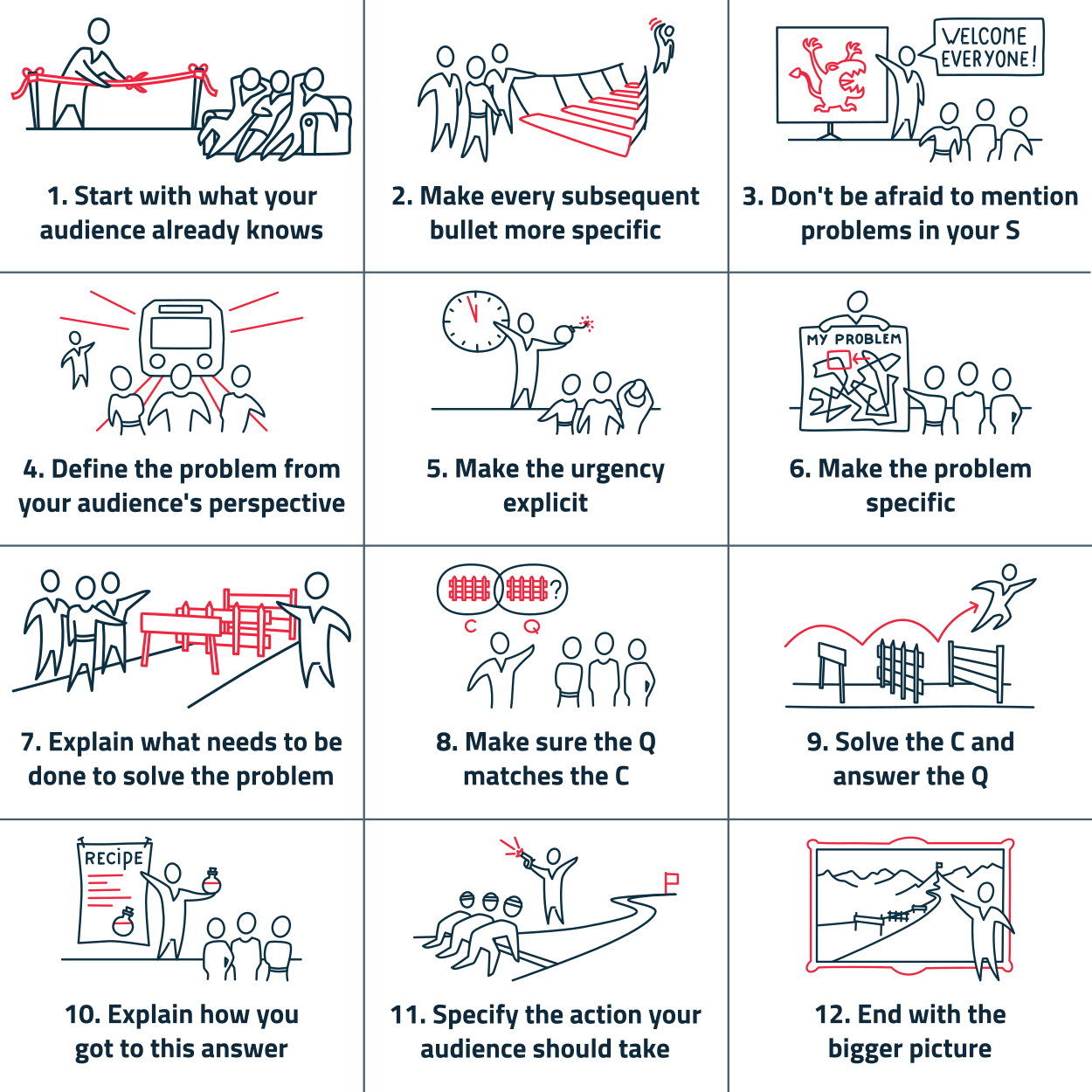Dit artikel is bedoeld voor mensen die de basis van het SCQA-model kennen en er zelf grondig mee aan de slag willen. Ken je het SCQA-model nog niet? Lees dan eerst onze introductie van de SCQA.
Een goede verhaalstructuur bevat een Situatie, Complicatie, Vraag (Question) en Antwoord: SCQA. Als je je verhaal opbouwt als SCQA krijgt je verhaal een aantrekkelijke spanningsboog en kun je ook complexe onderwerpen gestructureerd behandelen.
De volgende vraag is uiteraard: hoe maak je zo’n SCQA? Waar moet je op letten? Hoe maak je je verhaal sterker en wat zijn de valkuilen? In dit artikel ga ik uitgebreid op die vragen in aan de hand van twaalf do’s and don’ts.
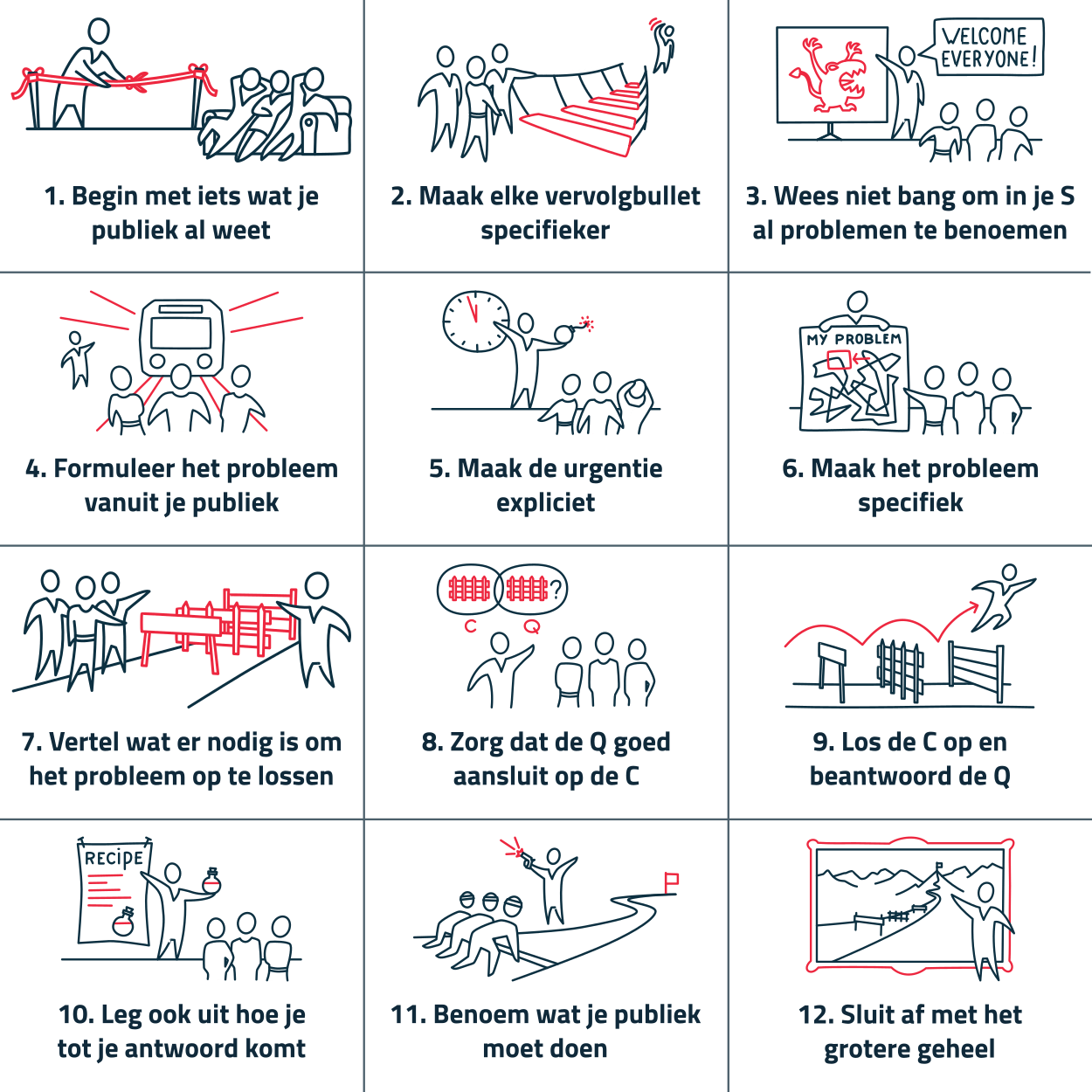
Do’s en don’ts voor de Situation (S)
De S is het vertrekpunt van je verhaal. Hier creëer je een gedeelde basis met je publiek. De S begint daarom met herkenbare punten die je publiek onderschrijft.
1. Begin met iets wat je publiek al weet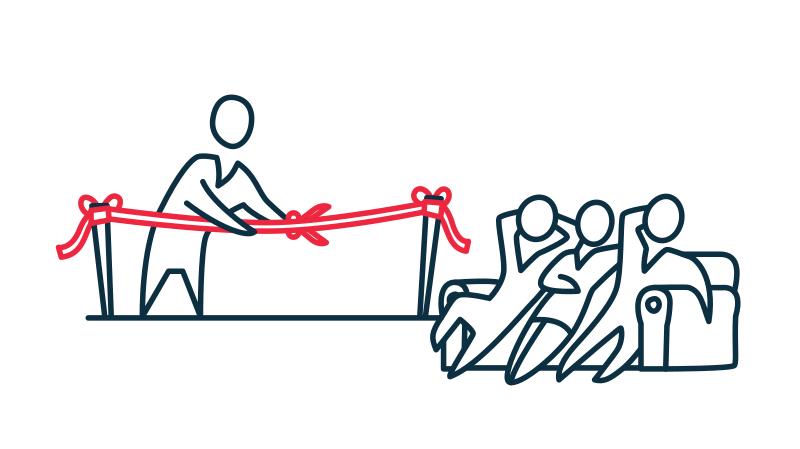
Bij de eerste bullet moet je dus al goed nadenken over je publiek. Wat voor het ene publiek vanzelfsprekend is, is voor het andere publiek nieuw en complex. Neem bijvoorbeeld de volgende zin:
- Er zijn twee soorten beroertes: ischemische en hemorragische.
Voor een publiek van medici is het prima om met deze informatie te beginnen. Maar deze informatie is niet voor iedereen bekend. Voor een breed publiek is daarom een ander vertrekpunt nodig. Bijvoorbeeld de volgende zin van de site van de Hartstichting:
- Bij een beroerte gaat er iets mis in de hersenen.
Je kunt controleren of een zin aan de herkenbaarheidseis voldoet door te proberen of je er ‘Zoals je al weet…’ voor kunt zetten. Soms kom je er daardoor achter dat een eerste zin die logisch klinkt toch geen herkenbaar vertrekpunt is. Als je twijfelt is het vaak goed om één extra, meer basale bullet of zin toe te voegen. De meeste mensen overschatten namelijk hoeveel hun publiek al van hun onderwerp weet.
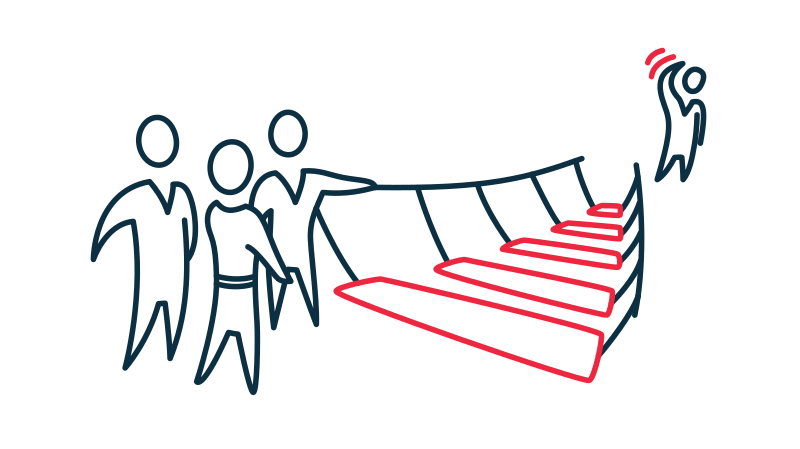
Je kunt je verhaal vergelijken met een trechter. Je verhaal begint breed en wordt bij elke stap specifieker en dus smaller. Een andere vergelijking die kan helpen is de zoomfunctie van Google Earth. Daarmee zoom je in van de hele wereld naar een continent naar een land naar een stad, et cetera, tot je eindigt in je eigen voortuin.
Een goede trechter-/inzoomstructuur ziet er bijvoorbeeld als volgt uit:
- [Bekend vertrekpunt] De laatste jaren is het aantal vluchtelingen naar de EU sterk toegenomen.
- Landen waar vluchtelingen aankomen (zoals Italië) hebben niet genoeg personeel voor goede asielprocedures.
- Daarom worden ook in andere landen (zoals Turkije en Niger) centra opgezet waar vluchtelingen een asielaanvraag kunnen doen.
- [Het onderwerp waar de auteur heen wil] Over de juridische status van deze centra is discussie.
Een alternatieve structuur zou er als volgt uit kunnen zien:
- In landen buiten de EU (zoals Turkije en Niger) zijn recent centra opgezet waar vluchtelingen een asielaanvraag kunnen doen voor EU-landen.
- Dit is een reactie op de toegenomen vluchtelingenstroom naar de EU.
- Door die toestroom kunnen EU-landen waar de vluchtelingen aankomen (zoals Italië) niet iedereen een goede asielprocedure geven.
- Over de juridische status van de centra is discussie.
De tweede versie werkt minder goed. Het verhaal heeft geen inzoomstructuur, waardoor de auteur in bullet vier terug moet komen op het onderwerp van bullet een. Hierdoor ervaart het publiek het verhaal als minder logisch en minder strak.
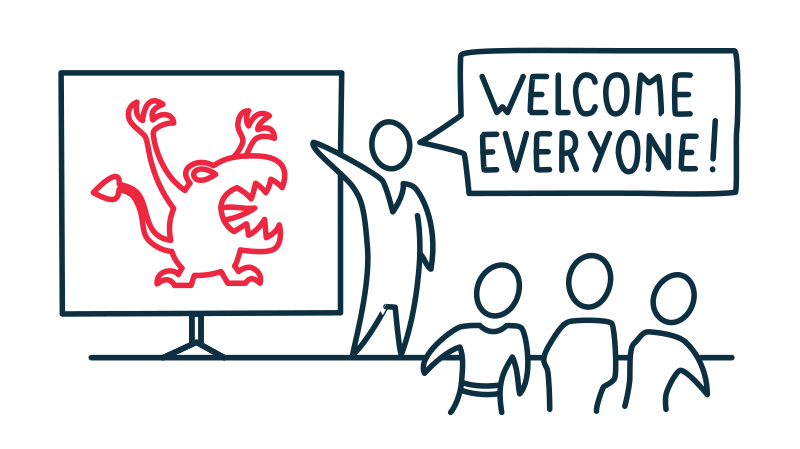
Het klopt dat de S de relatief stabiele achtergrond vormt voor de problemenDe Complicatie hoeft overigens niet altijd een probleem te zijn. Verhalen die draaien om een kans kan je ook in een SCQA-structuur gieten. In dat geval is die kans de Complicatie. Vervolgens beschrijf je in je C de hordes die genomen moeten worden om die kans te grijpen. die je in de C behandelt. Toch spelen er in die achtergrond meestal ook al problemen. Dit zijn grotere problemen, die je niet direct zelf oplost, maar die wel belangrijk zijn als context.
Voorbeelden van zulke problemen kwamen we al tegen in de verhaallijn over asielzoekerscentra buiten de EU (zie 2.):
- De laatste jaren is het aantal vluchtelingen naar de EU sterk toegenomen.
- Landen waar vluchtelingen binnenkomen (zoals Italië) hebben niet genoeg personeel voor goede asielprocedures.
Het uiteindelijke doel van deze SCQA is om een nieuwe definitie van extraterritoriaal asiel te introduceren. In de C moeten we daarom uitleggen dat de huidige definitie problematisch is. Om dat specifieke probleem goed te introduceren, moeten we ook ingaan op de vluchtelingencrisis en de slechte asielprocedures binnen de EU. Dat zijn ook problemen, maar die hebben dus de status van ‘achtergrond’.
Andere voorbeelden van achtergrondproblemen zijn de opwarming van de aarde en een ongeneeslijke ziekte. Ook die los je meestal niet direct op in jouw verhaal.
Soms is onduidelijk of een probleem beter in de S of de C past. In dat geval kan er weinig misgaan: beide opties zijn prima. Uiteindelijk laat je de letters S,C,Q en A toch weg als je gaat schrijven of presenteren.Soms zal je in je uiteindelijke verhaal de volgorde van de SCQA veranderen. Je kan bijvoorbeeld met de C beginnen om meteen de urgentie te benadrukken. Als je op die manier met je SCQA gaat puzzelen, wordt het wat belangrijker om een scherpe grens te trekken tussen je Situatie en je Complicatie. Weet in ieder geval dat het ook een optie is om het grotere probleem in de S te bespreken.
Do’s en don’ts voor de Complication (C)
De C gaat in op het probleem. Waarom moet er nu actie ondernomen worden? En welke hordes moeten worden genomen om tot een oplossing te komen?
4. Formuleer het probleem vanuit je publiekMeestal zijn er meerdere perspectieven voor je verhaal mogelijk. In het verhaal over de asielzoekerscentra (zie 2.) kunnen bijvoorbeeld asielzoekers zelf problemen ervaren, of de regeringen van landen buiten de EU (zoals Turkije), of de regeringen van EU-landen.

Als het kan, werkt het het beste om in de C het perspectief van je publiek te kiezen. Door in te gaan op hun eigen problemen creëer je de meeste urgentie. Je verhaal wordt juist minder urgent als je het perspectief van jezelf of van je eigen organisatie kiest. Dat komt vaker voor dan je misschien denkt.
Laten we naar het voorbeeld kijken van een organisatie die bedrijven vraagt om gegevens over hun personeel en salarissen. Een e-mail geformuleerd vanuit de afzender kan er dan als volgt uitzien:
- Wij hebben niet genoeg data voor ons onderzoek naar de regionale arbeidsmarkt. Daardoor kunnen we geen betrouwbare uitspraken doen.
Dit is een probleem, maar de vraag is of dat het publiek genoeg kan schelen om in actie te komen. Zeker als je vraagt om concurrentiegevoelige data. Een alternatief, geformuleerd vanuit het publiek, werkt waarschijnlijk beter:
- Jullie bedrijf gaat de uitkomsten van ons onderzoek gebruiken. Jullie willen hiermee onder meer de juiste managers werven en salarisschalen te bepalen. Op dit moment is het niet mogelijk om tot betrouwbare uitspraken te komen in het onderzoek. Dit komt doordat er niet genoeg data beschikbaar zijn.
In dit voorbeeld is het relatief makkelijk om de C vanuit het perspectief van het publiek te formuleren. Dat komt doordat er een specifiek publiek is (het bedrijf) met een duidelijk doel (de onderzoeksresultaten gebruiken). Bij een breed publiek zonder duidelijk doel is dat moeilijker. In dat geval werkt het het beste om je C te formuleren vanuit het perspectief van de samenleving. Je gaat dan in op problemen voor bijvoorbeeld burgers, patiënten, leerlingen of consumenten.
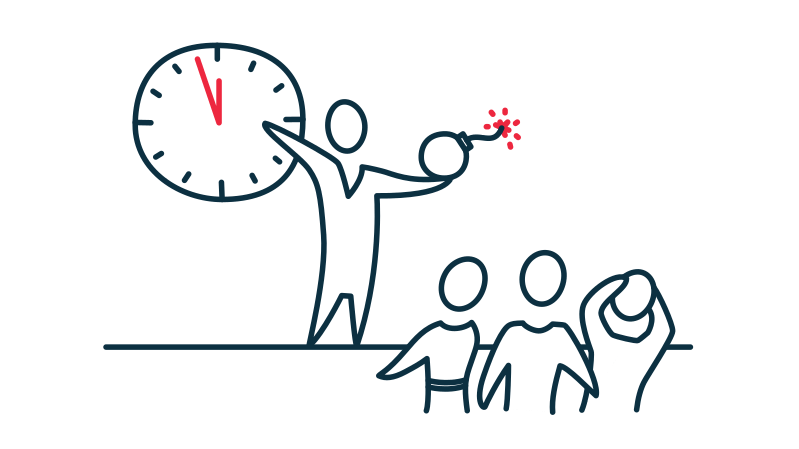
Een goede manier om de urgentie te expliciteren is door ‘so what?’ te vragen: waarom is dat een probleem? Op die manier benoem je niet alleen het probleem zelf, maar ook de gevolgen ervan. Twisting the knife heet dit in de verkoopwereld.
In het voorbeeld over de beroertes (zie 1.) kan dat er als volgt uitzien:
- Aderverkalking kan plaatsvinden in de halsslagader, maar ook in andere aders richting de hersenen.
- So what?
- We weten niet of verkalking in die andere aders ischemische beroertes voorspelt. En we weten niet hoe de verkalking zich ontwikkelt.
- So what?
- Daardoor blijven mensen overlijden aan de gevolgen van beroertes en moeten veel anderen leven met de nare gevolgen ervan.
Bij de laatste zin is de urgentie helemaal expliciet: niemand zal ontkennen dat dit een probleem is.
Vaak is het nodig om de urgentie explicieter te maken dan je zelf denkt. Kenniswerkers vergeten bijvoorbeeld soms de urgentie te benadrukken omdat ze die vanzelfsprekend vinden, omdat ze van dag tot dag vooral bezig zijn met kleinere puzzels binnen hun vak, of omdat ze ‘iets niet weten’ (zie bullet 2 hierboven) op zichzelf al problematisch vinden.
Je moet de urgentie goed benadrukken, maar uiteraard niet overdrijven. Overselling tast je geloofwaardigheid aan en werkt averechts.
Een veelgemaakte fout is het kiezen van een te grote, ambitieuze C. Bijvoorbeeld:
- Schepen stoten veel CO2 uit.
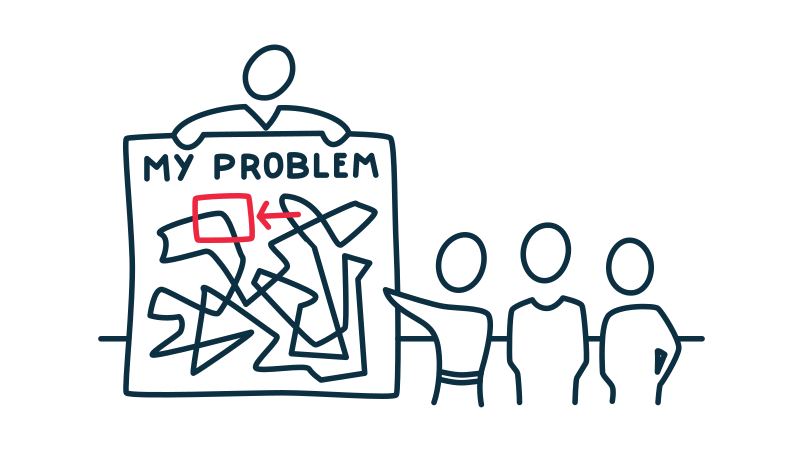
Een dergelijk probleem is urgent, maar waarschijnlijk is dit een achtergrondprobleem (zie 3.) dat je niet direct oplost. Het is daarom belangrijk om daarom niet alleen dit grote probleem te benoemen, maar ook in te zoomen op de specifieke problemen waar jij aan werkt. Bijvoorbeeld:
- Er lijkt een veelbelovende oplossing te zijn. De wrijving rond scheepsrompen zou verminderd kunnen worden door een luchtlaag rondom de romp te creëren, en de romp te coaten.
- Dat zou het brandstofgebruik van schepen (en dus de C02-uitstoot) sterk reduceren.
- We weten alleen niet of deze oplossing praktisch mogelijk is, wat voor ontwerp de romp zou moeten hebben, en welke coating het beste werkt.
Als je het probleem niet op deze manier specifiek maakt ontstaat er een kloof tussen de C en de A. Je publiek ervaart daardoor in de A slechts een deeloplossing: enkel een coating op scheepsrompen gaat het CO2-emissieprobleem niet oplossen. Dat gevoel voorkom je door je een oplosbaar probleem te formuleren in je C.
Om deze reden is het verstandig om naast het probleem ook een oplossingsrichting of een handelingsperspectief te introduceren. Dat doe je door uit te leggen wat er nodig is om het probleem op te lossen. Welke hordes zijn er?

In het voorbeeld over de beroertes (zie 1. en 5.) kan dat er zo uitzien:
- [probleem] We weten niet of aderverkalking de beroertes voorspelt.
- [horde] We weten niet hoe verkalking zich ontwikkelt en ook niet wanneer deze zo ernstig is dat behandeling nodig is.
- [horde] We weten niet hoe we verkalking het best kunnen meten. Elk van de twee beschikbare technieken hebben nadelen: MRI is duur en CT stelt patiënten bloot aan straling.
Op deze manier maak je het specifieke probleem nog specifieker (zie 6.). Ook bereid je je publiek verder voor op je A. Goede hordes leiden als het ware tot een lijst met eisen waaraan je A moet voldoen.
Do’s en don’ts voor de Question (Q)
De Q stelt de vraag hoe de hordes uit de C genomen kunnen worden.
8. Zorg dat de Q goed aansluit op de C
Soms formuleren mensen een Q die breder (minder specifiek) is dan de C. Dat leidt tot een minder strakke verhaalopzet. Bijvoorbeeld:
- [C] Onze universiteit heeft geen Masterprogramma over digitale wetgeving.
- [Q] Hoe kunnen we inspelen op digitale trends?
Deze Q is onnodig breed. Er zijn wel tien manieren waarop de universiteit kan inspelen op digitale trends. Als er uiteindelijk maar één wordt besproken, ervaart je publiek een kloof tussen Q en A.
Het tegenovergestelde gebeurt soms ook: mensen maken hun Q juist té specifiek. Dat ziet er bijvoorbeeld zo uit:
- [C] Onze universiteit heeft geen Masterprogramma over digitale wetgeving.
- [Q] Hoe kunnen we een Masterprogramma over digitale wetgeving opzetten waarvan de afgestudeerden van waarde zijn voor de Nationale Politie?
Een nieuw begrip in de Q (in dit geval ‘de Nationale Politie’) betekent vaak dat de Q niet goed aansluit op de C. Je kunt dit meestal oplossen door dat nieuwe begrip al in de C een plek te geven.
Als je de Q op hetzelfde niveau als de C formuleert, wat voegt die dan nog toe? In feite inderdaad niks. Om die reden laat je de Q in een tekst of een presentatie ook vaak weg. Toch is het goed om in je SCQA de Q altijd uit te schrijven. Je moet de SCQA namelijk zien als denkmiddel waarmee je grip krijgt op je verhaalstructuur. De Q helpt je zien of alle onderdelen in die structuur goed verbonden zijn.
Do’s en don’ts voor de Answer (A)
De A geeft de oplossing voor de C en laat zien hoe de hordes genomen kunnen worden.
9. Los de C op en beantwoord de Q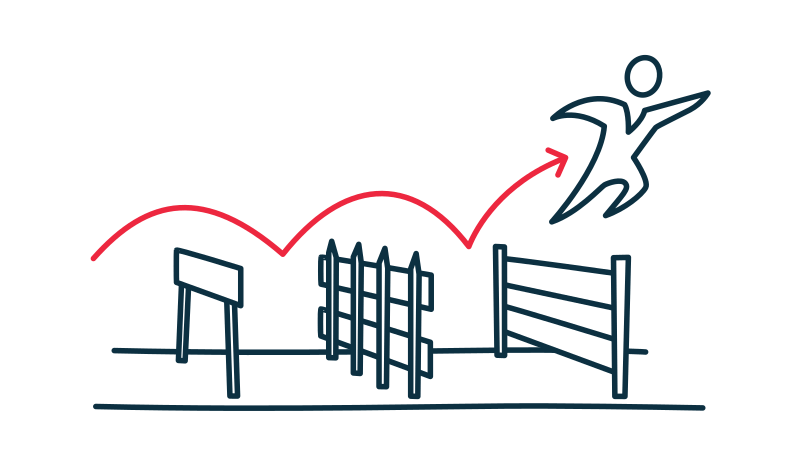
In zo’n opzet bevat bullet C1 een probleem, stelt Q1 daarover een vraag en geeft A1 daarop – met twee subbullets – het antwoord. Schematisch ziet de verhaalstructuur van ons voorbeeld over scheepsrompen (zie 6.) er dan zo uit:
C
- De wrijving rond scheepsrompen zou verminderd kunnen worden door een luchtlaag rondom de romp te creëren, en de romp te coaten.
- [C1] We weten alleen niet wat voor ontwerp de romp zou moeten hebben,
- [C2] en we weten ook niet welke coating het beste werkt.
Q
- [Q1] Welk scheepsrompontwerp is het meest geschikt…,
- [Q2] en welke coating is het meest effectief…
- …om de wrijving rondom scheepsrompen en daarmee het brandstofgebruik te verminderen?
A
- [A1] We hebben de nieuwe techniek op de meest voorkomende rompontwerpen X, Y en Z getest:
- [A1a] computersimulaties wezen uit dat bij schepen met romp type X de meeste winst te behalen is.
- [A1b] Deze resultaten zijn met waterbaktesten gevalideerd.
- [A2] We hebben verschillende coatings getest:
- [A2a] Coating A bleek effectief, maar slijt snel.
- [A2b] Coating B bleek even effectief en slijtvaster.
Uiteraard kan het ook goed zijn dat je in één A-bullet meerdere C’s oplost of dat je in de A juist meer bullets nodig hebt om een C op te lossen. Om die reden is het goed om ook voor je publiek te expliciteren waar je welke C oplost en waar je welke Q beantwoordt. Je publiek moet een bullet als A1a direct kunnen herkennen als oplossing van C1.
Als er een C is waar je A geen oplossing voor biedt, voeg je die ontbrekende informatie toe aan je A. Als dat niet kan verwijder je die bullet in de C of pas je die aan zodat je hem wel kunt oplossen. Dat doe je meestal door de C specifieker te formuleren (zie 6.).
Op basis van de C en de Q kun je je A controleren, maar je kunt ook andersom werken. Je begint dan met je A en denkt vanuit dat vertrekpunt na over een bijbehorende C en de Q. Dat is handig als je al weet wat je A zal zijn – of dat nu een complete oplossing is of enkel een plan van aanpak (zie 10.).
- [Q] Is het mogelijk om een luchtlaag rond de romp van een schip te maken?
- [A] We hebben een luchtlaag rond de romp van het schip gemaakt.
Je kunt dit soort storende herhaling voorkomen door niet alleen te benoemen dat de Q wordt beantwoord en de hordes uit de C worden genomen, maar ook hoe dat gebeurt. Je beschrijft bijvoorbeeld de computersimulaties en de testen in waterbakken die je hebt gedaan. Op die manier breng je de oplossing tot leven en geef je die diepte. Ook in je A wordt je verhaal dus weer specifieker, net zoals dat het geval was in de S (trechter, zie 2.) en in de C (hordes, zie 7.).

Bij een subsidieaanvraag of een projectvoorstel heb je nog geen resultaten. Maar ook dan kun je ingaan op het hoe door je werkwijze of je plan van aanpak te bespreken. Juist als je nog geen resultaten hebt is dat extra belangrijk. Je moet dan immers aannemelijk maken dat die er gaan komen.

Als het kan, is het goed om dit soort doelen in je A te laten terugkomen. Vaak kun je dat doen door gewoon expliciet te benoemen wat het publiek moet doen om de C op te lossen. Dat kan heel praktisch worden. Bijvoorbeeld:
- Om
de Master over digitale wetgeving te kunnen opzetten moet het
college voor 1 april:
- het conceptplan lezen en goedkeuren;
- € 20.000 beschikbaar stellen voor de ontwerpfase en € 100.000 voor het eerste jaar;
- voor april, mei en juni 3 fte beschikbaar stellen vanuit de rechtenfaculteit, en 1 fte ondersteunend personeel;
- de aanvraag voor de accreditatieorganisatie ondertekenen en verzenden.
Soms zijn je doelen minder praktisch dan in dit voorbeeld. Je wilt bijvoorbeeld alleen iets vertellen over je onderzoek of het publiek informeren over het nieuwe beleid. Mensen hoeven daar vervolgens niks mee te doen. Als je zelf dit soort doelen benoemt, is het goed om je af te vragen waarom je precies gaat communiceren. In sommige gevallen is communicatie helemaal niet nodig. Maar meestal stuit je uiteindelijk toch wel op een meer actiegericht doel. Bijvoorbeeld feedback krijgen op je onderzoeksopzet of een vervolgafspraak over mogelijke samenwerking maken. Je verhaal wordt sterker als je je van dat doel bewust bent en het een plek geeft in je A.
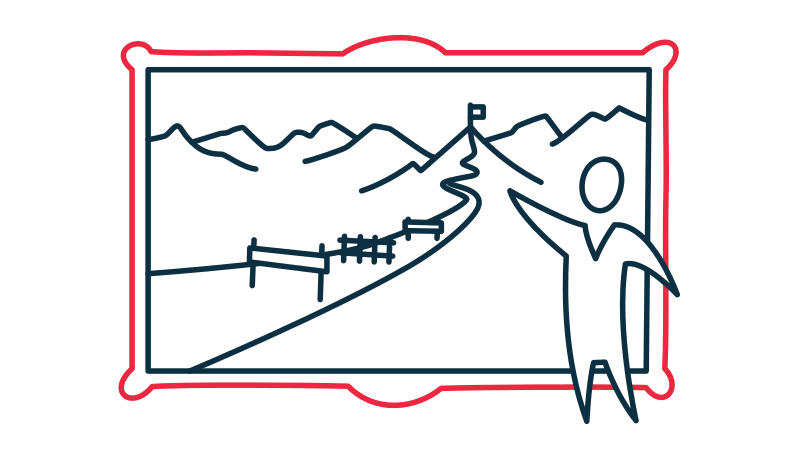
Een goede manier om af te sluiten is door uit te zoomen naar het grotere plaatje. De trechter die steeds smaller is geworden (zie 2.) krijgt als het ware onderaan weer een brede uitloop. Vaak doe je dat door de urgentie uit de C te herhalen, of terug te keren naar de grotere achtergrondproblemen die daaraan ten grondslag liggen (zie 3.). Je publiek ziet alle de details die aan bod zijn gekomen dan weer in het licht van het grotere geheel.
Vaak zoom je uit door in te gaan op vragen als ‘Waarom deden we dit ook alweer?’ ‘Wat hebben we bereikt? Of ‘Wat willen we bereiken?’ ‘Wat konden we eerst niet en nu wel?’ Je benadrukt bijvoorbeeld dat een belangrijke stap gezet is op weg naar beter begrip van een ziekte. Met de nieuwe kennis als basis is gericht vervolgonderzoek mogelijk, waar we voorheen moesten zoeken naar de spreekwoordelijke speld in de hooiberg.
Succes met je verhaallijnen!
Een verhaal over een complex onderwerp goed structureren blijft lastig, ook voor mensen die dat elke dag doen. Als je deze do’s en don’ts volgt voorkom je veelgemaakte fouten en moet je een goede eerste stap kunnen zetten. Veel succes met je verhaallijnen!
Verder leren?
We maken momenteel een online SCQA-cursus. Kun je ons helpen deze cursus supernuttig te maken (in 1 minuut)?

Arnaud is trainer, adviseur en tekstschrijver bij Analytic Storytelling. Hij helpt klanten om een heldere en overtuigende boodschap op papier te krijgen in woord en beeld.



